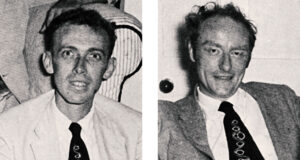Wilkins’ and Gosling’s results were intriguing enough to be communicated to the scientific community. Researchers regularly share their findings and ideas with one another so that others can evaluate and build upon them. Scientific conferences provide a direct way of doing this. In May of 1951, Wilkins set off to present the results at a conference in Italy. There, these tantalizing clues would inspire another scientist to join in the race for the structure of DNA.

James Watson was studying biochemistry at the Naples Marine Station — but he spent every spare moment reading about genes and the molecules they might be made of. Although Watson began his career studying birds, he had switched to genetics as a graduate student. He felt that understanding genes was essential to figuring out how life worked — and all the latest evidence suggested that genes were made of DNA. So when Wilkins presented his findings — the most detailed information then available on the structure of DNA — Watson was in the audience, watching with interest. He could see from Wilkins’ results that there was a repeating pattern to DNA’s structure. If he could just figure out what caused that pattern, he thought he would be able to unravel the structure itself.

Inspired by this clue, Watson decided to devote all his time and energy to understanding the structure of DNA. At first, he wanted to join Wilkins’ lab — but Wilkins didn’t have any room. Instead, in the autumn of 1951, he joined another lab specializing in X-ray diffraction, at Cambridge University. There, he shared Wilkins’ and Gosling’s clue about DNA with someone who would soon join him in the race for the structure of DNA, Francis Crick.

Like Wilkins, Crick had started out as a physicist. During World War II, he put his scientific training to work designing underwater mines. After the war, he got interested in studying the physical basis of life and joined a Cambridge biology lab. There, Crick launched into an investigation of protein structure — but his concentration on this project was soon to be interrupted by Watson’s arrival in the lab.
Watson’s enthusiasm for DNA was contagious. He was convinced by the published results suggesting that genes were made of DNA. And though he did not yet know that a helical structure had been suggested for DNA, he had seen the evidence from Wilkins’ presentation indicating that the structure of DNA was simple enough to solve. Watson shared this evidence with Crick — who eventually decided to join the race himself.

When Wilkins communicated his results to the community, he inspired other researchers to investigate the problem. To review the many functions that communication within the scientific community serves, visit Analysis within the scientific community.
